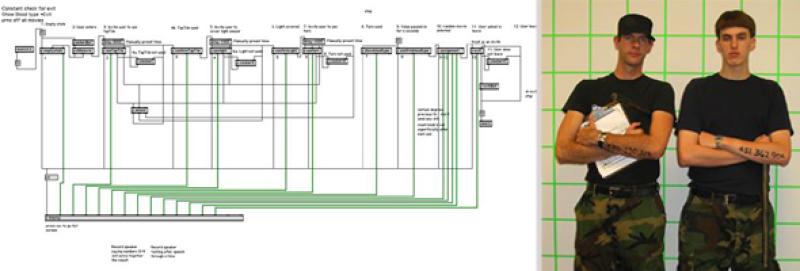PAWNS
Summary:
PAWN was an interactive installation in ACCAD's motion capture lab where soldiers led participants through a simulation of a future draft registration process.

P.-atriotic A.-mericans W.-ho N.-ever S.-urrender
Researcher:
Fran Kalal, Design
Summary:
In August of 2003 Fran Kalal created an interactive installation in ACCAD's motion capture lab. Participants were led by "soldiers" (played by two actors), through a simulation of a future draft registration process. Hidden cameras detected the participant's presence, causing a large video screen to address them. They are ordered to select their blood type with a dial, and have their hand scanned by a severe military figure. They are then given their assignment and instructed to exit. Failure to comply with instructions resulted in intervention and expulsion by the soldiers.
The project began with extensive state charting taking into account the possibilty that the participants in the piece may not understand or follow the given dirctions the first time. The final patch was designed to repeat the directions until the action was carried out. Manual overrides were also built in so that an operator could advance the system if a sensor malfunctioned or a participant acted in a way not accounted for in the design of the patch. Some of the sub patches included a frame difference patch, random movie patch, sensor patch, and chroma key patch. The frame difference patch compared the last received fram from a live video source wth the current fram to decided whether of not there was motion. This sub patch told the main patch whether or not the module was recently entered or exited. The random sub patch read randomly selected text lines from a text document to decide what movie would play next when the module was empty. As each movie was loaded, the time was read into the subpatch and the next movie was selected after the completion of the previous movie. The sensor patch measured the MIDI outputs of three selected sensors only when the main patch instructed the sub patch to do so to limit processing time when not necessary. The chroma key sub patch used the sensor patch to select parts of a foreground image to impose based on color over a static image."
Completed in 2003.
Filters: Installations, Interactive Media
